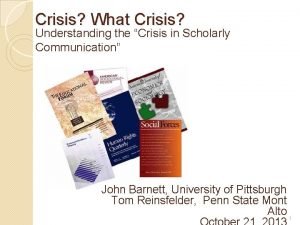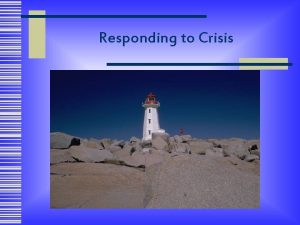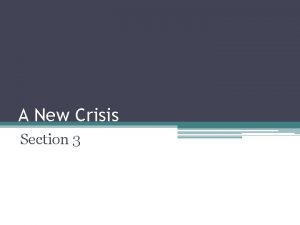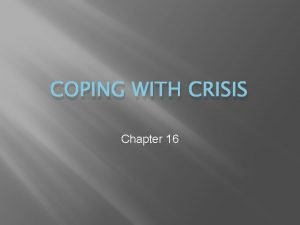Chapter 15 Section 2 The Crisis D e


























- Slides: 26

Chapter 15, Section 2 The Crisis D e epens

Key Terms 0 Harriet Beecher Stowe – daughter of an abolitionist minister; author of Uncle Tom’s Cabin 0 Uncle Tom’s Cabin – a novel published by Harriet Beecher Stowe in 1852, which portrayed slavery as brutal and immoral 0 Fugitive Slave Act – an 1850 law to help slaveholders recapture runaway slaves 0 Popular sovereignty – a system in which the residents vote to decide an issue 0 Kansas-Nebraska Act – an 1854 law that established the territories of Kansas and Nebraska and gave their residents the right to decide whether to allow slavery 0 John Brown – an extreme abolitionist; led the Pottawatomie Massacre, which led to civil war in Kansas.

Bell Ringer 1. Look at the maps of the United States on page 464. How many new slave states were added between 1820 and 1854? 2. How much more territory was open to slavery after 1854?

Objectives: • Summarize the main points of the Compromise of 1850. • Describe the impact of the novel Uncle Tom’s Cabin. • Explain how the Kansas-Nebraska Act reopened the issue of slavery in the territories. • Describe the effect of the Kansas-Nebraska Act.

What was the Compromise of 1850, and why did it fail? Congress passed the Compromise of 1850, a series of laws meant to solve the controversy over slavery. The bitterness between the North and South caused all attempts at compromise to fail.

The Compromise of 1850 included five laws that addressed issues related to slavery.

President Fillmore signed the compromise into law. Some of the new laws pleased the North, and others pleased the South. To Please the North • California admitted to the Union as a free state • Slave trade banned in Washington, D. C. To Please the South • Popular sovereignty used to decide slavery in the rest of the Mexican Cession • Tough new fugitive slave law

The Fugitive Slave Act of 1850 allowed officials to arrest anyone accused of being a runaway slave. Suspects had no rights to a trial. Northern citizens were required to help capture accused runaways.

Slave catchers would seize fugitives even after many years had passed since their escape. An Indiana man was separated from his wife and children when a slave owner claimed he had escaped 19 years ago. A wealthy tailor was seized, but his friends in New York quickly raised money to free him.

The Fugitive Slave Act was the most controversial part of the Compromise of 1850. Senator Calhoun hoped that it would force northerners to admit that slaveholders had rights to their property. Instead, it convinced more northerners that slavery was evil. Northerners began to resist the law.

The Fugitive Slave Act 0 1. Why did Southerners feel that the Fugitive Slave Act was justified? 0 They considered slaves to be property 0 2. What moral dilemma did the Fugitive Slave Act force Northerners to face? 0 To obey the law and “support” slavery 0 Break the law and oppose slavery


Harriet Beecher Stowe, the daughter of an abolitionist minister, was deeply affected by the Fugitive Slave Law. Stowe drew on some of her own experiences. Her family helped runaway slaves. In 1853, Stowe published the novel Uncle Tom’s Cabin, about an enslaved man who is abused by his cruel owner (Simon Legree).

Stowe’s novel provoked strong reactions from people on both sides of the slavery issue. Many northerners were shocked and began to view slavery as a serious moral problem rather than a political issue. Many white southerners said it was propaganda, misleading information meant to further a cause.

Uncle Tom’s Cabin (1852) 0 3. Why did white Southerners resent Uncle Tom’s Cabin? 0 They believed the book falsely criticized the South and slavery

The debate over slavery continued with the Kansas and Nebraska territories. Southerners refused to admit the territories because they lay above the Missouri Compromise line. In 1854, Senator Stephen Douglas helped pass the Kansas-Nebraska Act. The Kansas. Nebraska Act Allowed the people in the territories to decide the slavery issue by popular sovereignty.

The act undid the Missouri Compromise.

North and South were divided over the Kansas. Nebraska Act. Southerners supported the act. Northerners were outraged. They hoped the new territories would become slave states. They felt Douglas had betrayed them into allowing more slave states. Nevertheless, the act was signed into law by President Franklin Pierce.

The Kansas-Nebraska Act 0 4. What is popular sovereignty? 0 System where the residents vote to decide an issue 0 5. What groups of people supported the Kansas-Nebraska Act? What groups opposed it? 0 Southerners supported it because it repealed the Missouri Compromise. People opposed to slavery also opposed the Act. 0 6. How did the Kansas-Nebraska Act change decisions about slavery? 0 Turned it over to the people (popular sovereignty)

Thousands of proslavery and antislavery settlers immediately poured into Kansas. Each side wanted to hold a majority in the vote on slavery. Kansas soon had two governments, one antislavery and one proslavery.

Violence broke out. Bands of fighters began roaming the territory, terrorizing those who did not support their views. The violence was so bad that it earned Kansas the name “Bleeding Kansas. ”


“Bleeding Kansas” 0 7. How did proslavery forces ensure that Kansas would elect a proslavery legislature? 0 They rushed to settle in the territory 0 5, 000 people from Missouri came and voted in the election illegally 0 8. Why did proslavery forces attack Lawrence, Kansas? 0 Antislavery settlers boycotted the official government and made their own. Political authority was in dispute. 0 9. What effects did John Brown’s actions at Pottawatomie have on the situation in Kansas? 0 Civil war broke out


The violence in Kansas spread over into the United States Senate. Abolitionist Charles Sumner spoke out against proslavery Senator Andrew Butler’s nephew beat Sumner unconscious in the Senate chamber. By 1856, all attempts at compromise had failed.

Violence in Congress 0 10. How did Northerners react to the beating of Senator Charles Sumner? 0 They were shocked at the violence in the Senate 0 11. In what ways did the beating of Senator Sumner represent what was happening in the nation? 0 Great divide between the North and South; differences were leading to violence.
 Myasthenic vs cholinergic crisis
Myasthenic vs cholinergic crisis Section quick check chapter 10 section 1 meiosis answer key
Section quick check chapter 10 section 1 meiosis answer key Hình ảnh bộ gõ cơ thể búng tay
Hình ảnh bộ gõ cơ thể búng tay Frameset trong html5
Frameset trong html5 Bổ thể
Bổ thể Tỉ lệ cơ thể trẻ em
Tỉ lệ cơ thể trẻ em Voi kéo gỗ như thế nào
Voi kéo gỗ như thế nào Chụp tư thế worms-breton
Chụp tư thế worms-breton Chúa yêu trần thế alleluia
Chúa yêu trần thế alleluia Môn thể thao bắt đầu bằng chữ f
Môn thể thao bắt đầu bằng chữ f Thế nào là hệ số cao nhất
Thế nào là hệ số cao nhất Các châu lục và đại dương trên thế giới
Các châu lục và đại dương trên thế giới Công thức tiính động năng
Công thức tiính động năng Trời xanh đây là của chúng ta thể thơ
Trời xanh đây là của chúng ta thể thơ Cách giải mật thư tọa độ
Cách giải mật thư tọa độ Làm thế nào để 102-1=99
Làm thế nào để 102-1=99 Phản ứng thế ankan
Phản ứng thế ankan Các châu lục và đại dương trên thế giới
Các châu lục và đại dương trên thế giới Thể thơ truyền thống
Thể thơ truyền thống Quá trình desamine hóa có thể tạo ra
Quá trình desamine hóa có thể tạo ra Một số thể thơ truyền thống
Một số thể thơ truyền thống Cái miệng bé xinh thế chỉ nói điều hay thôi
Cái miệng bé xinh thế chỉ nói điều hay thôi Vẽ hình chiếu vuông góc của vật thể sau
Vẽ hình chiếu vuông góc của vật thể sau Nguyên nhân của sự mỏi cơ sinh 8
Nguyên nhân của sự mỏi cơ sinh 8 đặc điểm cơ thể của người tối cổ
đặc điểm cơ thể của người tối cổ Thứ tự các dấu thăng giáng ở hóa biểu
Thứ tự các dấu thăng giáng ở hóa biểu Vẽ hình chiếu đứng bằng cạnh của vật thể
Vẽ hình chiếu đứng bằng cạnh của vật thể


















































